Selecting [Standard] to Install
This explains the procedure for searching for a device on a network and installing a driver ([Standard]).
Prerequisites
The device is one that is on the same subnet as the computer you are using (for TCP/IP network environments)
Enabling settings for both [Use WSD] and [Multicast Discovery Settings] at the device (for network environments that use WSD)
Setting the page description language selection (plug and play) function of the device
Set [PDL Selection (Plug and Play)] at the device to match the driver you are using. For details about the setting method, refer to the manual of the device.
The device must be in the same subnet as the computer you are using.
When starting the computer, log on as a user with administrator privileges.
Procedures
1.
Start the installer.
If you are using an installer downloaded from the web site
Double-click the downloaded file to decompress it. If the installer does not start automatically after it is decompressed, double-click [Setup.exe].
If you are using the accompanying CD-ROM
(1) Set the CD-ROM in the computer.
If the CD-ROM menu is not displayed, click the subsequent "Open details."
Start the installer by following the procedure below.
If a message prompting you to insert a CD-ROM is displayed or if Windows Explorer is displayed: Execute [MInst.exe].
If nothing is displayed: Double-click the CD-ROM icon.
If the above [MInst.exe] does not exist: Execute [Setup.exe] in the driver folder of the CD-ROM.
If you executed [Setup.exe], proceed to step 2.
(2) If the language selection screen is displayed, select a language → click [OK].
(3) Click [Installation] from the menu screen.
(4) If the [Select the Type of Connection] screen is displayed, select [Network Connection] → click [Next].
(5) On the [Installation] screen, confirm that the fax driver is selected → click [Install].
(6) Confirm the content of the CANON SOFTWARE LICENSE AGREEMENT → click [Yes].
Select a language → click [Next].
3.
When the CANON SOFTWARE LICENSE AGREEMENT is displayed, confirm the content → click [Yes].
4.
Select [Standard] → click [Next].
[Reactivate Faxes in the Sleep Mode and Search]: Select this when you want to detect devices on the network that are in sleep mode.
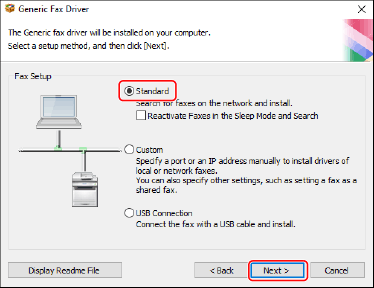
5.
Select the required items → click [Next].
[Process to Install Fax Driver]: Select this if necessary if a driver is already installed.
[Canon Driver Information Assist Service]: Select this when you want to use the device information retrieval function.
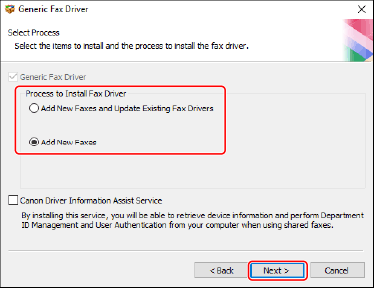
6.
Select the device to install from [Fax List].
[IPv4 Devices]/[IPv6 Devices]: The search results are displayed on the sheet corresponding to the connection method of the device. Click a sheet to switch to it.
[Search Options]: Change the time for searching for devices. This enables you to extend the time spent searching for devices when devices are not displayed in [Fax List].
You can enter the SNMP community name specified in the device to display the discovery results.
Set this when a name other than the default name "public" is specified in the device.
[Search Again]: Click this if the device is not displayed in [Fax List]. If the device is still not displayed after re-searching, select [Custom] and install by specifying a port or IP address.
 NOTE
NOTEIf you cannot discover a device connected by a WSD port, there could be a problem with the operating system or device settings. Refer to the following to enable the device to be displayed in the search results.
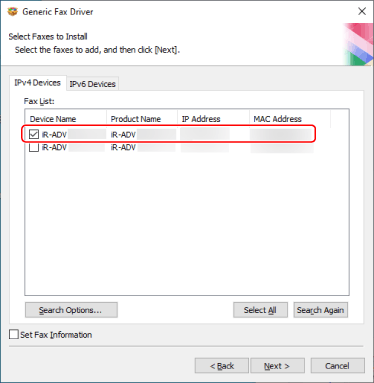
7.
If you want to change the name of the device, or set it as the default device, select [Set Fax Information] → click [Next].
If you do not want to change the name of the device or set it as the default device, click [Next] and proceed to step 9.
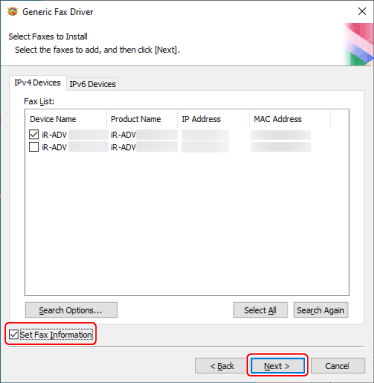
8.
Change [Fax Name] if necessary → click [Next].
[Create a shortcut on the desktop for Remote UI]: Creates a shortcut to the Remote UI of the device on the desktop.
To update the IP address of the device set in the shortcut after installing the driver, or delete the shortcut, do so manually.
[Set as Default]: Select this to set the device as the device that is normally used.
[Use as Shared Fax]: Select this if you want to configure shared settings for the device.
You cannot select [Fax Name] if the device is connected via a WSD port.
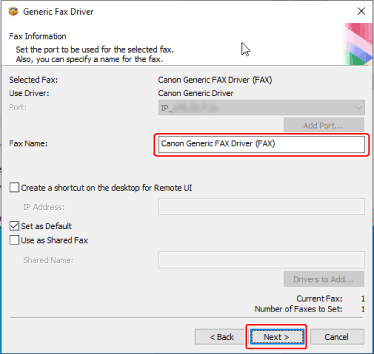
Check [Fax List for Driver Installation] → click [Start].
Proceed with the installation according to the instructions on the screen.
10.
Click [Restart] (or [Exit]).